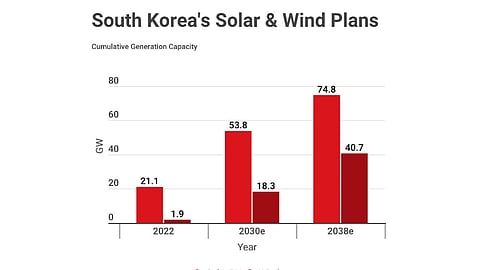

The South Korean Ministry of Trade, Industry and Energy (MOTIE) has released the country's draft blueprint of the 11th Basic Electricity Plan under which it has proposed to add 4.2 GW of new nuclear power plants by 2038.
Achieving this target entails expanding cumulative solar and wind power capacity to 72 GW by 2030 comprising 53.8 GW solar PV and 18.3 GW wind energy. It will be an increase from 23 GW in 2022. The latter comprised 21.1 GW solar PV and 1.9 GW wind.
Believing this capacity as not enough to suffice growing demand, the plan now expects to expand solar PV and wind energy further to 74.8 GW and 40.7 GW, respectively by 2038.
The blueprint, submitted to the ministry by a local group of experts tasked by the government, also includes plans to add 10.6 GW of new large nuclear power plants, small module reactors (SMR) and LNG cogeneration.
The current administration under Yoon Suk Yeol is towing a line different from his predecessor who advocated against nuclear power.
The country targets 70% of carbon-free power generation capacity in the electricity mix by 2038. Expecting its maximum electricity demand at 129.3 GW driven by semiconductor manufacturing, artificial intelligence (AI), data centers and industrial electrification, the government expects total power generation capacity to increase to 157.8 GW over the next 15 years.
The detailed draft plan is available on the ministry's website.
Back in January 2023, the Fitch Solutions Country Risk & Industry Research said the country will likely install about 46 GW cumulatively installed non-hydro power renewable energy capacity by 2032, led by solar PV (see South Korea's Non-Hydro RE To Account For 46 GW In 2032).
